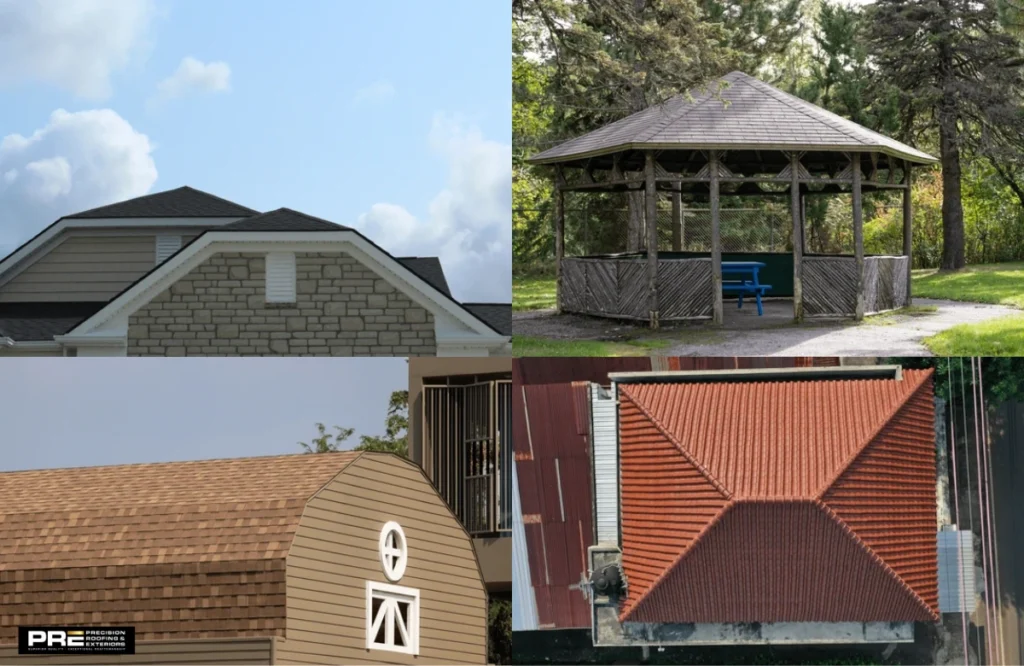When designing a home, the roof plays a huge role in style and structure. The hip roof is one of the most popular roofing styles because of its strength, durability, and classic look. Hip roofs slope on all four sides, making them more stable than gable roofs. They provide strong resistance against wind and heavy rain.
The main types of hip roofs include the simple, cross, and pyramid hip roofs. Other popular styles are the half-hipped, mansard, and pavilion roofs, while the Dutch gable roof combines features of gable and hip designs.
Most Common Types of Hip Roofs
Here are the different types:
1. Simple Hipped Roof
The simple hipped roof is the most common style. All four sides slope downward to the walls, usually of equal length, and meet at the ridge. It is simple in design and easy to build, making it a cost-friendly choice for homeowners.
Benefits:
- Great for wind resistance because of its sloping sides.
- Provides balanced shade around the home.
- A simple structure means lower construction costs.
2. Cross-Hipped Roof
A cross-hipped roof is created when two simple hip roofs are joined together, usually at a right angle. This design is often seen in larger houses with complex layouts. Depending on the building’s structure, it creates an “L” or “T” shaped roof.
Benefits:
- Provides a unique architectural style that enhances curb appeal.
- Works well for homes with additions or extensions.
- Offers excellent drainage and weather resistance.
3. Pyramid Hipped Roof
As the name suggests, this type of hip roof forms a pyramid shape because all four sides are equal in length and meet at a single point at the top. Pyramid hipped roofs are often used for smaller structures such as gazebos, pavilions, or small houses.
Benefits:
- Perfect for smaller buildings where symmetry is desired.
- Strong against wind from all directions.
- Adds a clean and balanced look to outdoor structures.
4. Half Hipped Roof
A half-hipped roof is like a traditional hip roof with shorter sides on two ends. These partial hips reduce the slope on certain sides, giving the home a mix of gable and hip roof features.
Benefits:
- Provides more attic or upper-floor space than a full hip roof.
- Creates room for larger windows, adding more natural light.
- Offers a unique look that combines style and function.
5. Mansard Roof
A mansard roof is a more complex design with two slopes on each side. The lower slope is steeper than the upper one, creating extra living or storage space under the roof.
Benefits:
- Maximizes space in the attic or upper floors, often used for extra rooms.
- Elegant design that adds character to homes.
- It can increase property value due to the added living space.
6. Pavilion Roof
A pavilion roof is similar to a pyramid-hipped roof but is usually larger and covers a square or rectangular building. All four sides slope evenly, meeting at one point in the middle. This hip roof type is common in pavilions, gazebos, and garden houses.
Benefits:
- Perfect for outdoor structures where full weather protection is needed.
- Looks attractive from all angles due to its symmetry.
- Allows efficient water drainage from all sides.
7. Dutch Gable Roof
The Dutch gable roof combines a gable and a hip roof. It has the sloping sides of a hip roof, but with a small gable at the top. This design gives the house a distinctive style while still offering the stability of a hip roof.
Benefits:
- Provides extra attic space compared to a simple hip roof.
- Allows installation of larger windows for better light and ventilation.
- Blends traditional and modern design elements.
Conclusion
Hip roofs are versatile, stylish, and built to withstand harsh weather conditions. From the simple hipped roof to the Dutch gable roof, each style offers unique benefits in terms of looks, strength, and functionality. If you are considering building or renovating your home, exploring the different types of hip roofs can help you find the design that best fits your needs.
For expert roofing installation and professional advice, contact expert roofing contractor Precision Roofing to bring your roof design to life with quality and care.

